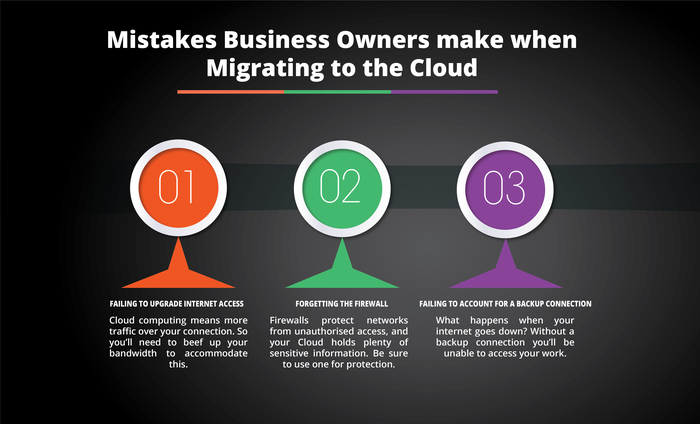Covered in this article:
Have local companies experienced fallout/loss/agony when migrating to the Cloud?
The risks with migrating to the cloud are precisely the same when installing a new server, and these risks are significantly mitigated by having a good project manager and documented and well-structured policies and competent engineers. It’s important for business owners to take the time to understand the term “cloud” and that it simply illustrates that the servers you will be using, are in a data centre and accessed via the internet, instead of in your server room, access by your local area network (LAN) via a cable.
What is the reason(s) for such incidents?
The most common incident is a loss of data, which can occur anytime, and usually happens because of a lack of current backups which should ALWAYS be the first step in any project or system change. Second to this is likely a failure in business continuity or “downtime” because the internet connection has not been set up or specified correctly and now the business is not fully functional (or operational at all) because their data is now in the cloud and unreachable due to this lack of connectivity or speed of connectivity.
How can businesses avoid making critical errors when migrating to the Cloud? (practical tips and tricks)?
-
- The servers, systems, and software that you are now using are accessible over the internet… therefore, uninterrupted, reliable and protected access to the internet has now become the most important requirements of the business and THIS is where mistakes are often made with the most common critical errors being:
- Not upgrading their internet access to ensure it is fast enough to allow the workforce to engage properly with the systems and software that are now “cloud-based”
- Ensuring the staff, the businesses data and the intellectual property is adequately protected with a firewall
- Ensuring internet access is redundant by adding a second (and different) method of connectivity. The most common (and best practice) solution to this would be to have a fibre connection that is guaranteed by the provider under a service level agreement and then have a wireless, microwave or LTE solution as a fall back connection in the event the primary goes down.
What are the most common myths/misunderstandings about migrating to the Cloud?
A common misconception is that the “cloud” is a cheaper solution to buying a server… it is not. It is a change in the methodology that you will follow to consume or interact with the technology in your business and importantly will alter the way you financially operate too. Instead of buying equipment (servers & storage), you will now pay a subscription service to access and use this equipment elsewhere in a data centre that someone else looks after (the cloud). This means that you will move away from a capital expenditure model (CAPEX) to an operational expenditure model (OPEX). Doing the math on a properly built cloud migration should show that the costs of technology are predominantly the same, but they are now shifted to monthly costs.
“All my data is perfectly safe because it’s in the cloud”… it’s not. It is safer than it was in the cupboard of your office… but a majority of the risks you faced when the data was local are still faced by businesses once they are in the cloud. You still need to closely guard access, security is just as important and backups remain the most critical thing in your business.
Who should oversee and guide this process?
An outsourced company is always best suited to take your business into the cloud. They have specialists to engage with on all the facets involved; licensing, connectivity, database access, backups, and security. Even if you have an internal IT team, it’s important to bring in specialists to handle a project of this nature, manage it accordingly and then hand it over on completion once it has been tested and signed off by all parties involved.
Turrito Networks and their subsidiary Dial a Nerd focus on cloud migrations monthly and currently have over 400 terabytes of client data in the cloud and over 4000 operational & fully licensed “seats” of Office 365 or Google across their client base.
What should every business owner know?
Today, having recognised the many critical benefits of migrating to the Cloud, savvy business owners are embracing the global shift to Cloud-based technology models. In today’s fast-paced and highly competitive business environment, businesses can no longer afford to rely on legacy infrastructure which is expensive to maintain and increasingly risky from a security point of view. Indeed, new and streamlined Cloud services enable every business to become more agile, responsive, secure and adaptive in the face of ongoing digital disruption.
When migrating to the Cloud, however, business owners, managers and leaders need to be aware of the potential risks involved – and take specific steps to mitigate these risks. Too often, services are migrated without this awareness, and without professional assistance – which can have disastrous consequences. For example, businesses can suffer data loss, which usually occurs because the business failed to implement regular backups. (Rule #1 one: Always backup your data!)
Another major risk is a failure in business continuity or prolonged ‘downtime’ because the internet connection is insufficient or doesn’t have adequate failover capability. This can shut down the business entirely because the data is now in the Cloud – and unreachable – due to the lack of a robust connectivity solution.
Preparation is Key
To begin with, it’s important to note that the risks associated with Cloud migration are precisely the same as those associated with installing a new server. The following elements significantly mitigate these risks: using an experienced project manager; developing, documenting and following well-structured policies; and utilizing qualified IT engineers. Once the technical work is out of the way many businesses forget about another key ingredient: training. Don’t wait until the last minute and send staff youtube links. Rather prepare for the training upfront and make sure it’s engaging enough to get buy-in.
Common mistakes you can avoid when migrating to the cloud
Having decided to move to the Cloud, it now becomes imperative that the business has uninterrupted, reliable and protected access to the internet. This is another place where mistakes are often made, with business owners/leaders making the following critical mistakes…
- Failing to upgrade internet access: You have to ensure that it is fast enough to allow your workforce to engage properly with the systems and software that are now ‘Cloud-based’. The days of running off of one ADSL line are over. Fibre has dropped in price to the extent that businesses should always consider this their first option.
- Failing to ensure that the staff, the businesses data and the intellectual property are protected by a firewall. Now that you have high-speed Internet and constant connectivity you must consider the increased threat of hacking. A firewall is one of the most fundamental defence mechanisms.
- Failure to consider endpoint security. Most Cloud platforms are extremely secure. More secure than having your server. However, all of that security counts for nothing if one of your users gets infected with malware or clicks a link they shouldn’t. Having top quality anti-virus software or ‘next-gen’ anti-virus software is key.
- Failing to ensure that internet access is redundant by adding a second (and different) method of connectivity: The most common (and best practice) solution to this would be to have a fibre connection that is guaranteed by the provider under a service level agreement; additionally, have a wireless/microwave or LTE solution as a failover connection in case the primary goes down. Very importantly make sure you have a router or firewall which can switch between links seamlessly and automatically.
Find the right Cloud partner
As with most services that are not core to your business, when migrating to the cloud it is critical to choose the right partner or provider. Without a doubt, an outsourced company is always best suited to migrate your business to the Cloud. These companies provide specialists to engage with your business and teams around every element: licensing, connectivity, database access, backups and security. Even if you have an experienced internal IT team, it’s important to engage with specialists to manage a project of this nature. Specialists will have the experience gained from multiple Cloud migrations, something an internal IT team will find difficult to get. The external team/provider should implement a handover and training once the new systems have been tested and signed off by all stakeholders.



